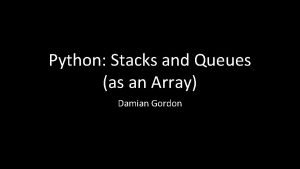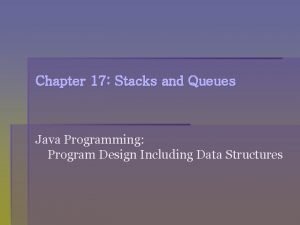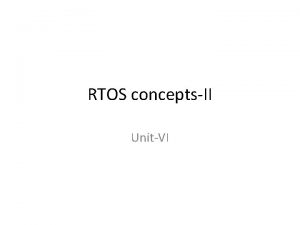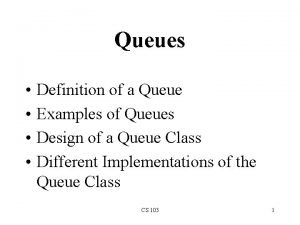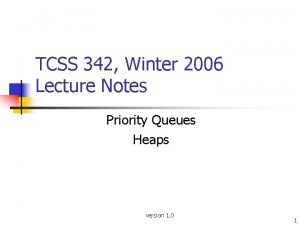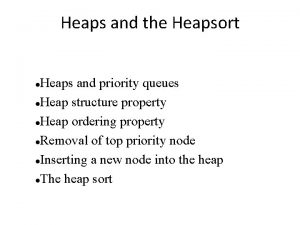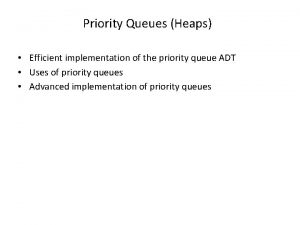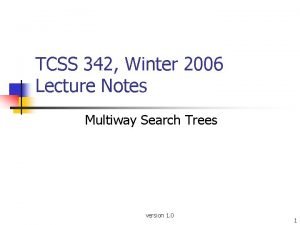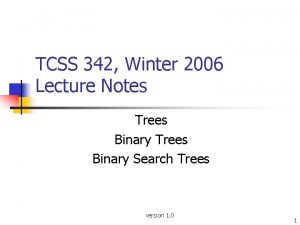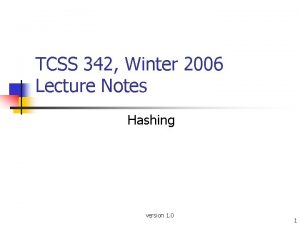TCSS 342 Lecture Notes Priority Queues and Heaps







































- Slides: 39

TCSS 342 Lecture Notes Priority Queues and Heaps Suggested reading from Weiss book: Ch. 21 These lecture notes are copyright (C) Marty Stepp, 2006. They may not be rehosted, sold, or modified without expressed permission from the author. All rights reserved. 1

Lecture outline n using priority queues n n implementing a priority queue using a heap n n n examples the priority queue abstract data type (ADT) Java's Priority. Queue class heap properties and examples add peek remove heap sort 2

Using priority queues 3

Motivating examples n we are a bank and we want to manage a collection of our customers' information n n we'll be performing many adds and removes we'd like to be able to ask the collection to remove or get the information about the customer with the minimum bank account balance another example: A shared Unix server has a list of print jobs to print. It wants to print them in chronological order, but each print job also has a priority, and higher-priority jobs always print before lower-priority jobs another example: We are writing a ghost AI algorithm for Pac-Man. It needs to search for the best path to find Pac-Man; it will enqueue all possible paths with priorities (based on guesses about which one will succeed), and try them in order 4

Some bad implementations n list: store all customers/jobs in an unordered list, remove min/max one by searching for it n n sorted list: store all in a sorted list, then search it in O(log n) time with binary search n n problem: expensive to add/remove binary search tree: store in a BST, search it in O(log n) time for the min (leftmost) element n n problem: expensive to search problem: tree could be unbalanced on nonrandom input balanced BST n n problem: in practice, if the program has many adds/removes, it performs slowly on AVL trees and other balanced BSTs problem: removal always occurs from the left side, which 5

Priority queue ADT n priority queue: an collection of ordered elements that provides fast access to the minimum (or maximum) element n n n a mix between a queue and a BST usually implemented using a structure called a heap priority queue operations: n add n n peek n n O(1) remove n n O(1) average, O(log n) worst-case - returns the minimum element - removes/returns minimum element O(log n) worst-case is. Empty, clear, size, iterator n O(1) 6

Java's Priority. Queue class public class Priority. Queue<E> implements Queue<E> n public Priority. Queue<E>() n public Priority. Queue<E>(int capacity, Comparator<E> comp) n n n Constructs a priority queue that uses the given comparator to order its elements. public public void add(E o) void clear() Iterator<E> iterator() E peek() E remove() 7

Implementing a priority queue using a heap 8

Heap properties n heap: a tree with the following two properties: n 1. completeness complete tree: every level is full except possibly the lowest level, which must be filled from left to right with no leaves to the right of a missing node (i. e. , a node may not have any children until all of its possible siblings exist) Heap shape: 9

Heap properties 2 n 2. heap ordering a tree has heap ordering if P < X for every element X with parent P n n n in other words, in heaps, parents' element values are always smaller than those of their children implies that minimum element is always the root is every a heap a BST? Are any heaps BSTs? Are any BSTs heaps? 10

Which are min-heaps? 10 20 30 10 wrong! 20 80 40 15 20 40 50 700 60 80 60 99 700 80 85 10 85 50 10 20 wrong! 40 60 20 40 99 10 wrong! 20 80 60 85 50 700 10 99 80 40 80 60 99 11

Which are max-heaps? wrong! 30 10 48 20 21 80 10 14 24 33 10 7 3 50 30 17 30 25 10 wrong! 30 40 22 35 28 18 9 11 12

Heap height and runtime n height of a complete tree is always log n, because it is always balanced n n this suggests that searches, adds, and removes will have O(log n) worst-case runtime because of this, if we implement a priority queue using a heap, we can provide the O(log n) runtime required for the add and remove operations n-node complete tree of height h: h = log n 2 h n 2 h+1 - 1 13

Adding to a heap n when an element is added to a heap, it should be initially placed as the rightmost leaf (to maintain the completeness property) n heap ordering property becomes broken! 10 20 40 50 10 80 60 700 65 85 20 99 40 50 80 60 700 65 85 99 15 14

Adding to a heap, cont'd. n to restore heap ordering property, the newly added element must be shifted upward ("bubbled up") until it reaches its proper place n n bubble up (book: "percolate up") by swapping with parent how many bubble-ups could be necessary, at most? 10 20 40 50 10 80 60 700 65 85 15 15 99 40 50 80 20 700 65 85 99 60 15

Adding to a max-heap n same operations, but must bubble up larger values to top 16 5 3 16 18 11 18 3 18 11 5 16 3 11 5 16

Heap practice problem n Draw the state of the min-heap tree after adding the following elements to it: 6, 50, 11, 25, 42, 20, 104, 76, 19, 55, 88, 2 17

The peek operation n peek on a min-heap is trivial; because of the heap properties, the minimum element is always the root n n peek is O(1) peek on a max-heap would be O(1) as well, but would return you the maximum element and not the minimum one 10 20 40 50 80 60 85 99 700 65 18

Removing from a min-heap n min-heaps only support remove of the min element (the root) n n n must remove the root while maintaining heap completeness and ordering properties intuitively, the last leaf must disappear to keep it a heap initially, just swap root with last leaf (we'll fix it) 10 20 40 700 50 65 80 60 65 85 20 99 40 700 50 80 60 85 99 65 19

Removing from heap, cont'd. n must fix heap-ordering property; root is out of order n n shift the root downward ("bubble down") until it's in place swap it with its smaller child each time n What happens if we don't always swap with the smaller child? 65 20 40 700 50 20 80 60 85 40 99 50 700 80 60 85 99 65 20

Heap practice problem n Assuming that you have a heap with the following elements to it (from the last question): 6, 50, 11, 25, 42, 20, 104, 76, 19, 55, 88, 2 n Show the state of the heap after remove() has been executed on it 3 times, and state which elements are returned by the removal. 21

Turning any input into a heap n n we can quickly turn any complete tree of comparable elements into a heap with a build. Heap algorithm simply perform a "bubble down" operation on every node that is not a leaf, starting from the rightmost internal node and working back to the root n n why does this build. Heap operation work? how long does it take to finish? (big-Oh) 45 21 14 6 18 60 32 14 6 21 18 60 32 45 22

Array tree implementation n corollary: a complete binary tree can be implemented using an array (the example tree shown is not a heap) i Item Left 2*i Child 1 Pam 2 2 2 Joe 4 4 3 Sue 6 6 4 Bob 8 8 5 Mike 10 10 6 Sam -1 11 7 Tom -1 13 8 Ann -1 15 9 Jane -1 17 10 Mary -1 19 Right Child 3 5 7 9 -1 -1 -1 Pam Joe Bob Sue Mike Sam Tom Ann Jane Mary • Left. Child(i) = 2*i • Right. Child(i) = 2*i + 1 23

Array binary tree - parent i Item Parent 1 Pam -1 2 Joe 1 3 Sue 1 4 Bob 2 5 Mike 2 6 Sam 3 7 Tom 3 8 Ann 4 9 Jane 4 10 Mary 5 i /2 0 1 1 2 2 3 3 4 4 5 Pam Joe Bob Sue Mike Sam Tom Ann Jane Mary • Parent(i) = i / 2 24

Implementation of a heap n when implementing a complete binary tree, we actually can "cheat" and just use an array n n index of root = 1 (leave 0 empty for simplicity) for any node n at index i, n n index of n. left = 2 i index of n. right = 2 i + 1 25

Code for add method public boolean add(E element) { // grow array if needed if (this. size() >= this. elements. length - 1) { this. elements = this. resize(this. elements); } // place element into heap at bottom this. size++; this. elements[this. size] = element; this. bubble. Up(); return true; } 26

Code for peek method public E peek() { if (this. Empty()) { throw new Illegal. State. Exception(); } return this. elements[1]; } 27

Code for remove method public E remove() { E result = this. peek(); // move last element of array up to root this. elements[1] = this. elements[this. size]; this. elements[this. size] = null; this. size--; this. bubble. Down(); return result; } 28

The bubble. Up helper private void bubble. Up() { int index = this. size; while (has. Parent(index) && elements[index]. compare. To(parent(index)) < 0) { // parent/child are out of order; swap them int parent. Index = parent. Index(index); swap(elements, index, parent. Index); index = parent. Index; } } // helpers private boolean has. Parent(int i) { return i > 1; } private int parent. Index(int i) { return i/2; } private E parent(int i) { return elements[parent. Index(i)]; } 29

The bubble. Down helper private void bubble. Down() { int index = 1; while (has. Left. Child(index)) { int child. Index = left. Index(index); if (has. Right. Child(index) && right(index). compare. To(left(index)) < 0) { child. Index = right. Index(index); } } } if (elements[index]. compare. To(elements[child. Index]) > 0) { swap(elements, index, child. Index); // out of order index = child. Index; } else { break; } // helpers private int left. Index(int i) { return i*2; } private int right. Index(int i) { return i*2 + 1; } private boolean has. Left. Child(int i) { return left. Index(i) <= size(); } private boolean has. Right. Child(int i) { return right. Index(i) <= size(); } 30

Advantages of array heap n the "implicit representation" of a heap in an array makes several operations very fast n n n add a new node at the end (O(1)) from a node, find its parent (O(1)) swap parent and child (O(1)) a lot of dynamic memory allocation of tree nodes is avoided the algorithms shown usually have elegant solutions private void build. Heap() { for (int i = this. size() / 2; i > 0; i--) { this. bubble. Down(i); } } 31

Heap sort 32

Heap sort n heap sort: an algorithm to sort an array of N elements by turning the array into a heap, then doing a remove N times n n n the elements will come out in sorted order! we can put them into a new sorted array what is the runtime? 33

A max-heap n n the heaps shown have been minimum heaps because the elements come out in ascending order a max-heap is the same thing, but with the elements in descending order 34

Improved heap sort n n the heap sort shown requires a second array we can use a max-heap to implement an improved version of heap sort that needs no extra storage n n O(n log n) runtime no external storage required! useful on low-memory devices elegant 35

Improved heap sort 1 n n use an array heap, but with 0 as the root index max-heap state after build. Heap operation: 36

Improved heap sort 2 n state after one remove operation: n modified remove that moves element to end 37

Improved heap sort 3 n state after two remove operations: n notice that the largest elements are at the end (becoming sorted!) 38

Sorting algorithms review Selection sort Bubble sort Insertion sort Mergesort Heapsort Treesort Quicksort Best case n 2 n n n log 2 n Average case (†) n 2 n 2 n log 2 n Worst case n 2 n 2 n log 2 n n 2 † According to Knuth, the average growth rate of Insertion sort is about 0. 9 times that of Selection sort and about 0. 4 times that of Bubble Sort. Also, the average growth rate of Quicksort is about 0. 74 times that of Mergesort and about 0. 5 times that of Heapsort. 39
 3 min quiz
3 min quiz Priority queue adt
Priority queue adt Applications of priority queues
Applications of priority queues 01:640:244 lecture notes - lecture 15: plat, idah, farad
01:640:244 lecture notes - lecture 15: plat, idah, farad Burman's priority list gives priority to
Burman's priority list gives priority to Priority mail vs priority mail express
Priority mail vs priority mail express Www.tcss.net
Www.tcss.net Mypay tcss
Mypay tcss Mypay tcss
Mypay tcss Thomas cheung school
Thomas cheung school Tcss.net
Tcss.net Python queue clear
Python queue clear Java stacks and queues
Java stacks and queues Exercises on stacks and queues
Exercises on stacks and queues What are stacks
What are stacks Queue representation
Queue representation Message queue in unix
Message queue in unix Pipes in rtos
Pipes in rtos Queue adalah jenis antrian
Queue adalah jenis antrian Define a queue
Define a queue Erisone queues
Erisone queues Soft heaps of kaplan and zwick uses
Soft heaps of kaplan and zwick uses Electricity and magnetism lecture notes
Electricity and magnetism lecture notes Power system dynamics and stability lecture notes
Power system dynamics and stability lecture notes Microbial physiology notes
Microbial physiology notes Limits fits and tolerances
Limits fits and tolerances Parallel and distributed computing lecture notes
Parallel and distributed computing lecture notes 40h11 tolerance
40h11 tolerance Financial institutions and markets lecture notes ppt
Financial institutions and markets lecture notes ppt Mechatronics notes
Mechatronics notes Foetotomy
Foetotomy Power system dynamics and stability lecture notes
Power system dynamics and stability lecture notes Project planning and management lecture notes ppt
Project planning and management lecture notes ppt Heaps of love ice cream
Heaps of love ice cream Lazy binomial heap
Lazy binomial heap Skew heap
Skew heap Cumulus mean
Cumulus mean Geetika tewari
Geetika tewari Reheap up
Reheap up Tom heaps
Tom heaps











